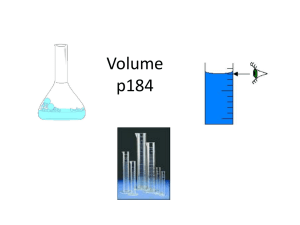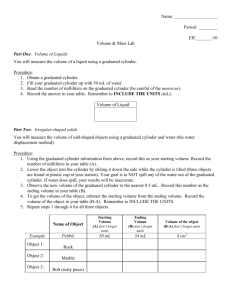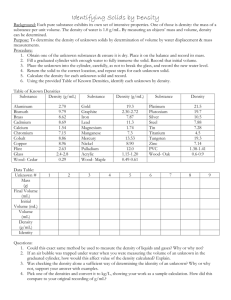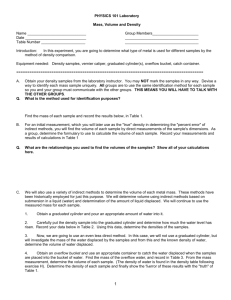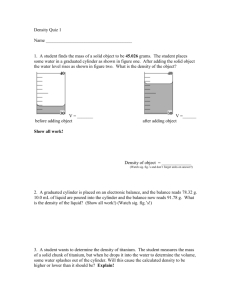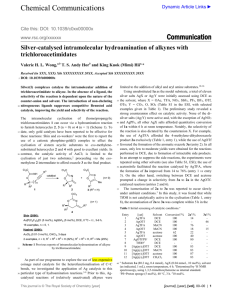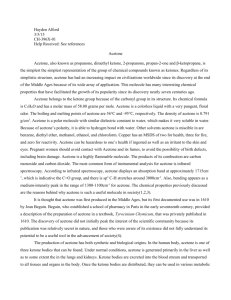Density lab revised
advertisement
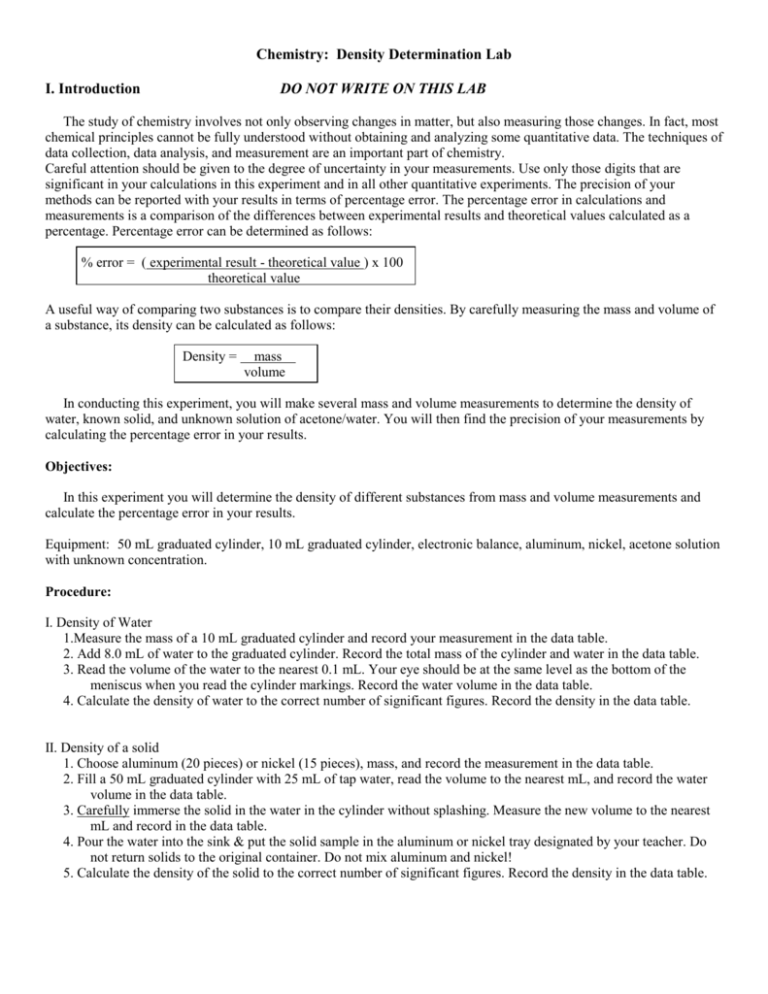
Chemistry: Density Determination Lab I. Introduction DO NOT WRITE ON THIS LAB The study of chemistry involves not only observing changes in matter, but also measuring those changes. In fact, most chemical principles cannot be fully understood without obtaining and analyzing some quantitative data. The techniques of data collection, data analysis, and measurement are an important part of chemistry. Careful attention should be given to the degree of uncertainty in your measurements. Use only those digits that are significant in your calculations in this experiment and in all other quantitative experiments. The precision of your methods can be reported with your results in terms of percentage error. The percentage error in calculations and measurements is a comparison of the differences between experimental results and theoretical values calculated as a percentage. Percentage error can be determined as follows: % error = ( experimental result - theoretical value ) x 100 theoretical value A useful way of comparing two substances is to compare their densities. By carefully measuring the mass and volume of a substance, its density can be calculated as follows: Density = mass volume In conducting this experiment, you will make several mass and volume measurements to determine the density of water, known solid, and unknown solution of acetone/water. You will then find the precision of your measurements by calculating the percentage error in your results. Objectives: In this experiment you will determine the density of different substances from mass and volume measurements and calculate the percentage error in your results. Equipment: 50 mL graduated cylinder, 10 mL graduated cylinder, electronic balance, aluminum, nickel, acetone solution with unknown concentration. Procedure: I. Density of Water 1.Measure the mass of a 10 mL graduated cylinder and record your measurement in the data table. 2. Add 8.0 mL of water to the graduated cylinder. Record the total mass of the cylinder and water in the data table. 3. Read the volume of the water to the nearest 0.1 mL. Your eye should be at the same level as the bottom of the meniscus when you read the cylinder markings. Record the water volume in the data table. 4. Calculate the density of water to the correct number of significant figures. Record the density in the data table. II. Density of a solid 1. Choose aluminum (20 pieces) or nickel (15 pieces), mass, and record the measurement in the data table. 2. Fill a 50 mL graduated cylinder with 25 mL of tap water, read the volume to the nearest mL, and record the water volume in the data table. 3. Carefully immerse the solid in the water in the cylinder without splashing. Measure the new volume to the nearest mL and record in the data table. 4. Pour the water into the sink & put the solid sample in the aluminum or nickel tray designated by your teacher. Do not return solids to the original container. Do not mix aluminum and nickel! 5. Calculate the density of the solid to the correct number of significant figures. Record the density in the data table. III. Finding the concentration of a solution of acetone & water using density. 1. Obtain an unknown solution of acetone & water. Record the unknown in the data table 2. Place a 10 mL graduated cylinder on a balance that has been tarred. Record the mass in the data table. 3. Transfer about 8 mL of solution into the graduated cylinder. Record the mass in the data table 4. Remove the graduated cylinder from the balance and place on the lab table. Record the volume of the solution in the cylinder to the correct number of significant figures. 5. From the mass and volume, calculate the density of your solution. Record this on the data table 6. Interpolate the density of your unknown solution by using the graph below. Concentration Curve 1.05 1 Density (g/mL) 0.95 0.9 0.85 0.8 0.75 0.7 0 20 40 60 80 100 % Acetone Solution IV. Lab Safety Be sure all glassware is washed and dried before placing it back. The specific hazard information for acetone is below: Health Rating: 1 - Slight Flammability Rating: 4 - Extreme (Flammable) Reactivity Rating: 2 - Moderate Contact Rating: 1 - Slight Lab Protective Equip: GOGGLES; LAB COAT; VENT HOOD; PROPER GLOVES; CLASS B EXTINGUISHER Storage Color Code: Red (Flammable) Chemistry: Density Lab Names: Period: Data Table - Be sure you record the correct number of significant figures for each measure (1 place past level of accuracy) I. Density of water Area for Showing your calculations. graduated cylinder _____________ g cylinder + water _____________ g mass of water _____________ g volume of water _____________ mL density of water _____________ g/mL II. Density of a solid Name of solid _______________________ Mass of solid _____________ g volume water _____________ mL volume water + solid _____________ mL volume of solid _____________ mL density of solid _____________ g/mL III. Concentration of Unknown solution using density Volume of solution _____________ mL Mass of solution _____________ g Density of solution _____________ g/mL From the graph above and your calculated density, find the % concentration of the acetone solution % Concentration of acetone solution _____________ % IV. Theoretical Density Values Density water ________g/mL – (find the defined density of water from your notes or book) Density solid ________g/mL – (from your periodic table) V. Conclusions Answer the following questions on the back side of this paper. 1. Describe briefly the method that is used to determine the volume of a solid. 2. Describe briefly the method that is used to find the mass of a liquid. 3. Calculate the percentage error for water & the solid. Remember significant figures and units! Show your work! 4. What were the major sources of error with the methods of measuring density that you used? 5. The method used to find the density of the unknown solid will not work for all solids. Why Not?



